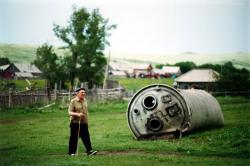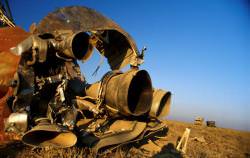People from the normally quiet and picturesque republic of Altai, Siberia keep their eyes on the sky when a launch occurs from the nearby Baikonur Cosmodrome, in Kazakhstan. This region is regularly littered with debris and toxic fuel from space launches, as Altai lies along the flight path of rocket launches to space. Unlike rockets launched from the Kennedy Space Center in Florida, which shed excess stages into the Atlantic Ocean, sections from rockets launched from Baikonur crash back on land, usually landing in the Altai region of the Kazakh steppe.
Two incidents of falling debris in the past two weeks prompted farmers to file claims against the Russian space agency for damages. Four horses were reportedly killed from traces of toxic fuel in found in space debris that landed on grazing land and another 4.5 meter chunk of metal landed very close to a house.
According to the Moscow Times, the Russian Federal Space Agency and Altai authorities have designated a strip of land where rocket debris is supposed to fall. People who live in the zone are given at least 24 hours’ notice of falling debris. Only those outside the zone are entitled to any compensation for damage caused by the launches.
The two recent incidents both occurred outside the zone, an official said.
In 2007, 27 people in the Ust-Kansky region were hospitalized with cancer-related illnesses they said were linked to contamination from falling debris. Also, in September 2007, a Proton-M rocket carrying a Japanese communications satellite malfunctioned around two minutes after takeoff, crashing near another Kazakh city, Zhezkazgan. No one was injured in the incident, but Russia paid Kazakhstan more than $2 million in compensation, after admitting that the rocket had been filled with higher-than-permissible levels of toxic heptyl fuel.

In cases where there is a rocket malfunction, the procedure is for ground control to destroy it, often spreading debris outside the expected area.
People from the region say that the Soviets thoroughly cleaned up debris from the discarded stages, but clean-up efforts have scaled back considerably since the Soviet Union fell. The pictures used here are from a 2002 photo essay by Norwegian photographer Jonas Bendiksen showing the large pieces of debris laying lying around the Altai region.
Original News Source: New York Times


K says:
>I would move away, but what do I know, LOL
Very little, obviously. It doesn’t really sound like a laughing matter.
[…] Pueden ver el trabajo completo en la página enlazada.
VÃa Nancy Atkinson – Universe Today (enlaces en inglés).
I wonder about the pros and cons of having this kind of toxic material on land, or in the oceans. At least on land you have a hope of clearing it up; and though material dropping into the ocean may be less likely to harm people directly, the overall consequences long term may be more serious and harder to identify or control.
I would move away, but what do I know, LOL
Our progress into space will be littered with stories like this.
Whether on land or in the ocean there is an impact – out of sight does not necessarily mean harmless. If we continue to explore space (and I hope we do) – we will need better ways of getting things into orbit. Maybe we need to seriously start development of the space elevator? I know this is not happening tomorrow – but a NASA study a few years ago proposed it could be done by 2050 if certain basic research is done first.
At least most of our space fuel is liquid hydrogen/oxygen. Maybe residue from the solid rocket boosters/////unless there is a catastrophic accident, most of its fuel would be burnt, wouldn’t it? What do our smaller rockets use?